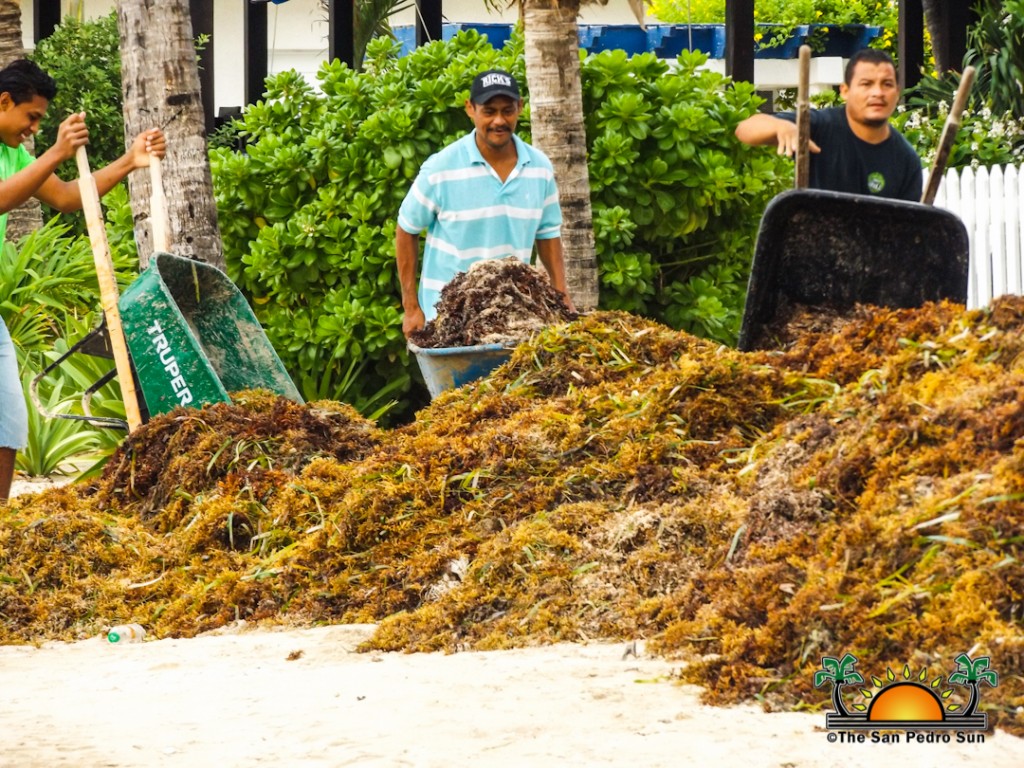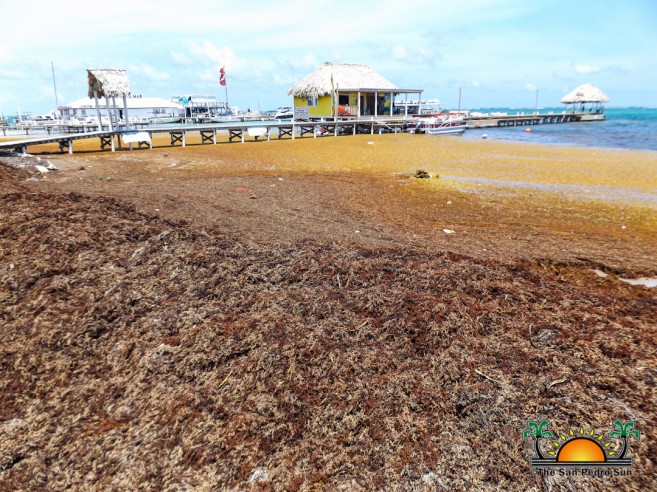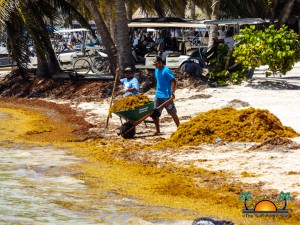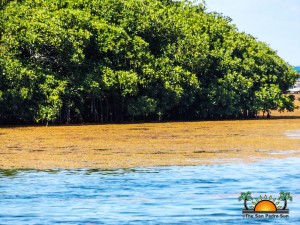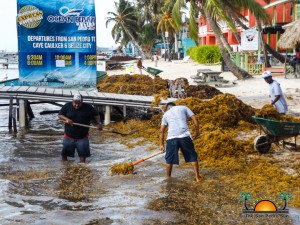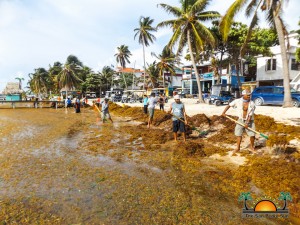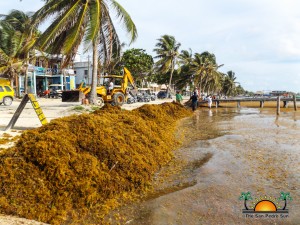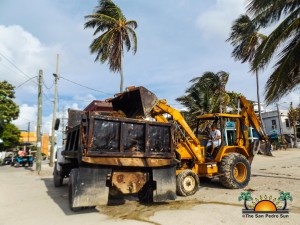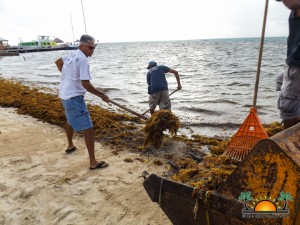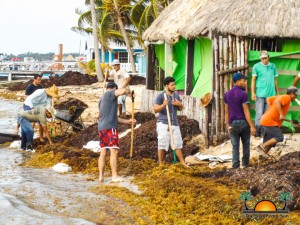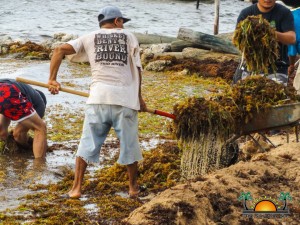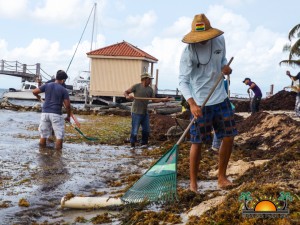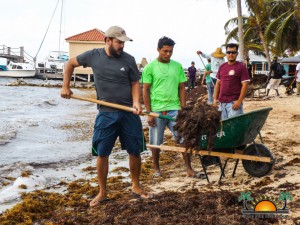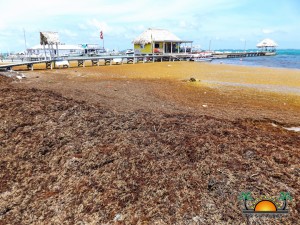The non-stop influx of Sargassum to the coasts of Belize, including Ambergris Caye, is threatening not only the tourism industry but human health as well. The supernatural phenomenon, which for months has been affecting La Isla Bonita, was declared a natural disaster by The San Pedro Town Council (SPTC) on Wednesday, September 26th via a press release.
As such, the local authorities invited the entire island community to join their collective efforts in addressing the issue in the short and long term. The first step took place early in the morning on Thursday, September 27th and Friday, September 28th with a massive community clean up from the Boca del Rio Area to the Mosquito Coast area south of San Pedro Town, in an attempt to remove as much of the invasive seaweed from the beaches as possible.
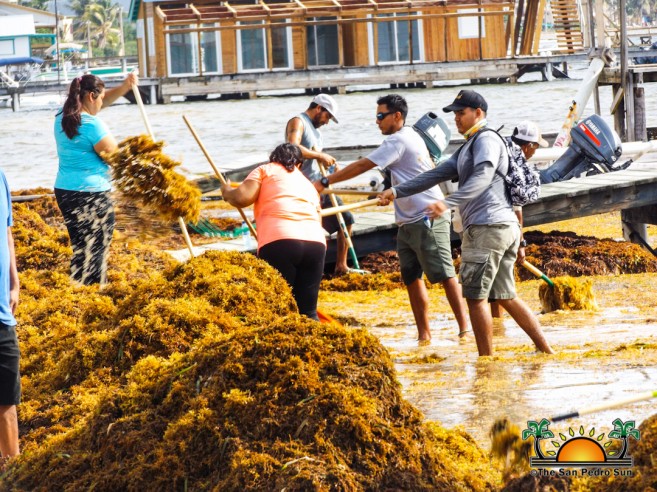 Hundreds of islanders answered the call to action and at 6AM, they convened at the Central Park from where they headed towards the beach in different groups. They tackled different areas along the stretch of beach in an effort to cover as much surface area as possible. Island residents were joined by Mayor Daniel Guerrero along with Councillors and staff of the SPTC, as well as the representative from the Opposition the People’s United Party Andre Perez, in the joint initiative that saw tons of the seaweed being removed from the island’s shores.
Hundreds of islanders answered the call to action and at 6AM, they convened at the Central Park from where they headed towards the beach in different groups. They tackled different areas along the stretch of beach in an effort to cover as much surface area as possible. Island residents were joined by Mayor Daniel Guerrero along with Councillors and staff of the SPTC, as well as the representative from the Opposition the People’s United Party Andre Perez, in the joint initiative that saw tons of the seaweed being removed from the island’s shores.
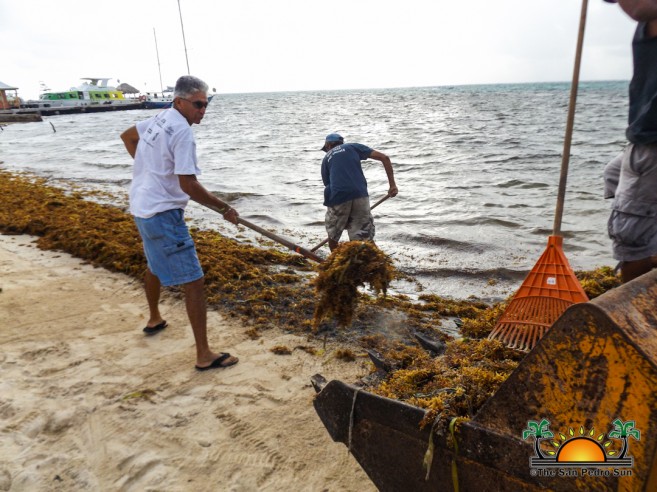 In its press release, the SPTC stated that over the past months, they have used all resources available to keep Sargassum at bay from the island’s coastline. However, the task is so overwhelming that the local government is asking for everyone’s assistance to address the situation. They called on the business and tourism sector, non-governmental organizations, government agencies and even Central Government to help them tackle the issue. The clean-up campaign was considered a short-term solution, meant to relieve the beach from the choking invasion. This initiative also includes the assistance of Belizean Marine Biologist and Consultant Miguel Alamilla, who will guide the SPTC efforts in finding ways to control the amount of Sargassum threatening the beaches of Ambergris Caye.
In its press release, the SPTC stated that over the past months, they have used all resources available to keep Sargassum at bay from the island’s coastline. However, the task is so overwhelming that the local government is asking for everyone’s assistance to address the situation. They called on the business and tourism sector, non-governmental organizations, government agencies and even Central Government to help them tackle the issue. The clean-up campaign was considered a short-term solution, meant to relieve the beach from the choking invasion. This initiative also includes the assistance of Belizean Marine Biologist and Consultant Miguel Alamilla, who will guide the SPTC efforts in finding ways to control the amount of Sargassum threatening the beaches of Ambergris Caye.
 Spearheading a long-term solution is Councillor Gary Greif, who is responsible for the environmental portfolio. Greif confirmed to The San Pedro Sun that he is leading the effort along with other stakeholders at acquiring water deflection booms. These would be placed at a 2/3 distance between the island and the barrier reef in hopes that it would keep the Sargassum from reaching the shore. It is expected that the placement of the booms will instead allow the current to take it past the southern end of the island. According to Greif, the response from the business and tourism sector has been positive, and they are in the process of purchasing similar types of booms. In the future, these will be able to be part of this long-term initiative. The SPTC believes that this collective effort will ensure the island to be free from Sargassum for the benefit of both island residents and visitors alike.
Spearheading a long-term solution is Councillor Gary Greif, who is responsible for the environmental portfolio. Greif confirmed to The San Pedro Sun that he is leading the effort along with other stakeholders at acquiring water deflection booms. These would be placed at a 2/3 distance between the island and the barrier reef in hopes that it would keep the Sargassum from reaching the shore. It is expected that the placement of the booms will instead allow the current to take it past the southern end of the island. According to Greif, the response from the business and tourism sector has been positive, and they are in the process of purchasing similar types of booms. In the future, these will be able to be part of this long-term initiative. The SPTC believes that this collective effort will ensure the island to be free from Sargassum for the benefit of both island residents and visitors alike.
 The strong smell from the decaying biomass along the shore has been affecting the many business establishments along the beach, who report a loss in customers due to the eyesore and the rotten-egg smell expelled by the piles of Sargassum amassed along the beach.
The strong smell from the decaying biomass along the shore has been affecting the many business establishments along the beach, who report a loss in customers due to the eyesore and the rotten-egg smell expelled by the piles of Sargassum amassed along the beach.
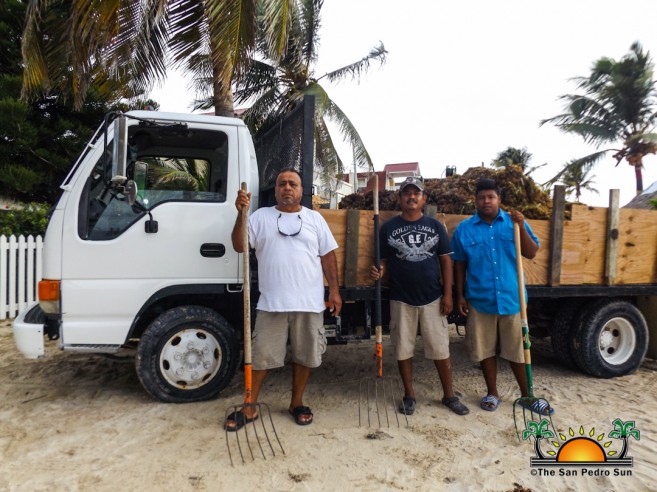 The epidemic of seaweed is believed to be hazardous to health due to the gas it emits as it rots. Hydrogen sulfide, a colorless and poisonous gas is expelled from the rotting seaweed. According to Eric Najarro from the Dr. Otto Rodriguez San Pedro Polyclinic II, inhaling small doses of this gas can trigger irritation of the eyes, respiratory issues and nausea. He cautioned that the groups at risk are asthma patients, elderly people, young babies, and pregnant women. To give an idea of how pervasive harmful the gas is, some residents residing or operating businesses near the sea area, reported that their silver and metal merchandise is rapidly tarnishing when exposed to the breeze tainted with the seaweed rotten odor. Some residents tested the theory using coins, showing the oxidization on over the course of 72 hours.
The epidemic of seaweed is believed to be hazardous to health due to the gas it emits as it rots. Hydrogen sulfide, a colorless and poisonous gas is expelled from the rotting seaweed. According to Eric Najarro from the Dr. Otto Rodriguez San Pedro Polyclinic II, inhaling small doses of this gas can trigger irritation of the eyes, respiratory issues and nausea. He cautioned that the groups at risk are asthma patients, elderly people, young babies, and pregnant women. To give an idea of how pervasive harmful the gas is, some residents residing or operating businesses near the sea area, reported that their silver and metal merchandise is rapidly tarnishing when exposed to the breeze tainted with the seaweed rotten odor. Some residents tested the theory using coins, showing the oxidization on over the course of 72 hours.
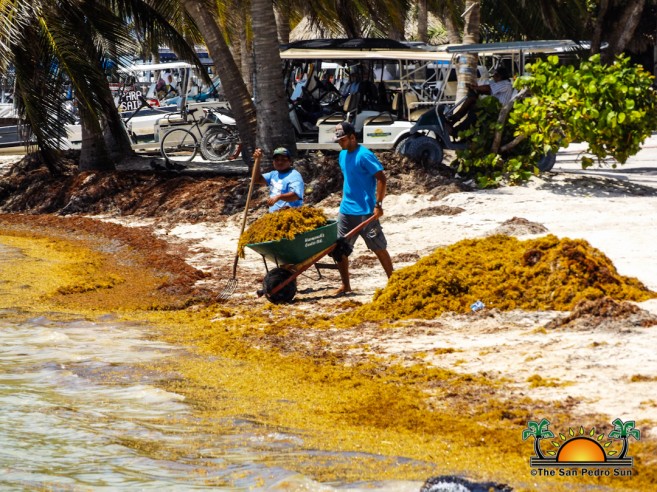 Those experiments are another indication of the damage that can be caused to someone’s lungs, explained Najarro, which can result in severe respiratory irritation, causing fluids to build up in the lungs. Exposed to very high concentrations of hydrogen sulfide can quickly lead to death. These fatal effects have been seen in marine wildlife near the shore. In several occasions, dead fish and other sea creatures have turned up dead on the shores, as the Sargassum consumes all oxygen in the surrounding area.
Those experiments are another indication of the damage that can be caused to someone’s lungs, explained Najarro, which can result in severe respiratory irritation, causing fluids to build up in the lungs. Exposed to very high concentrations of hydrogen sulfide can quickly lead to death. These fatal effects have been seen in marine wildlife near the shore. In several occasions, dead fish and other sea creatures have turned up dead on the shores, as the Sargassum consumes all oxygen in the surrounding area.
 Despite rumours that the influx of the invasive seaweed is slowing down, the SPTC will continue monitoring the beaches, and another round of aggressive beach cleaning is already being planned for the upcoming weeks if needed. The SPTC also indicated that the Sargassum collected will be given to those families that need it for landfill, while the remainder will be used to enhance the road access to the cemetery south of town.
Despite rumours that the influx of the invasive seaweed is slowing down, the SPTC will continue monitoring the beaches, and another round of aggressive beach cleaning is already being planned for the upcoming weeks if needed. The SPTC also indicated that the Sargassum collected will be given to those families that need it for landfill, while the remainder will be used to enhance the road access to the cemetery south of town.

